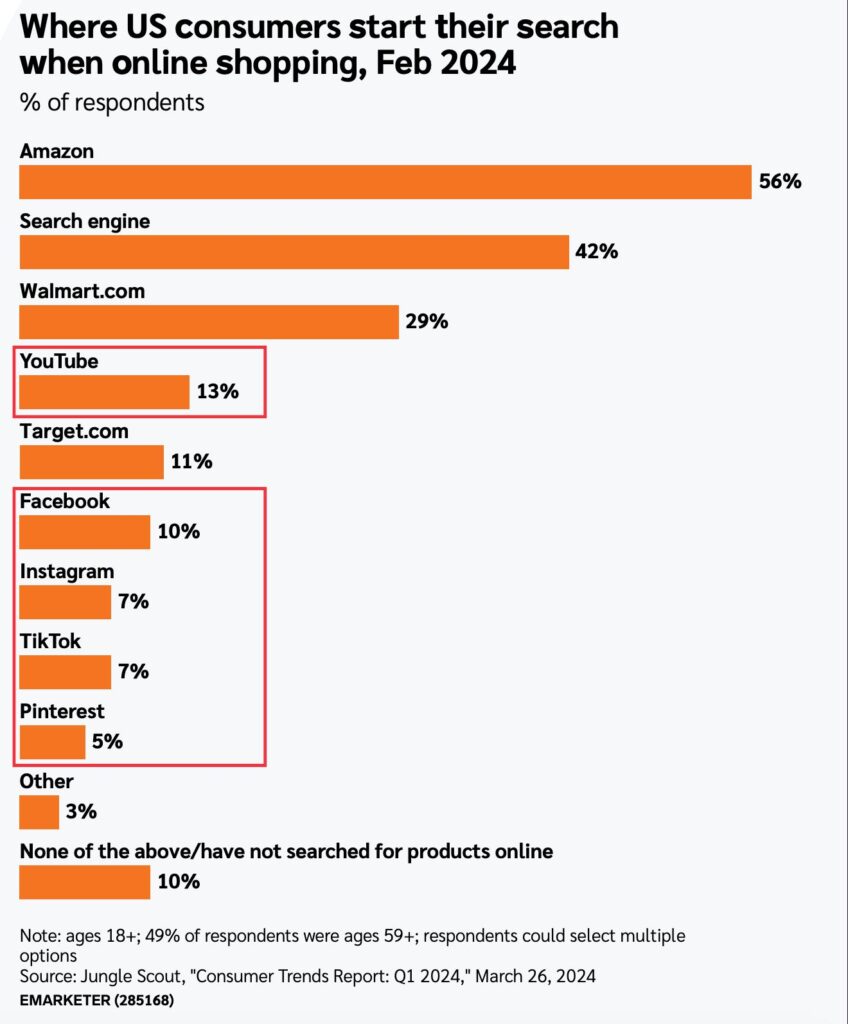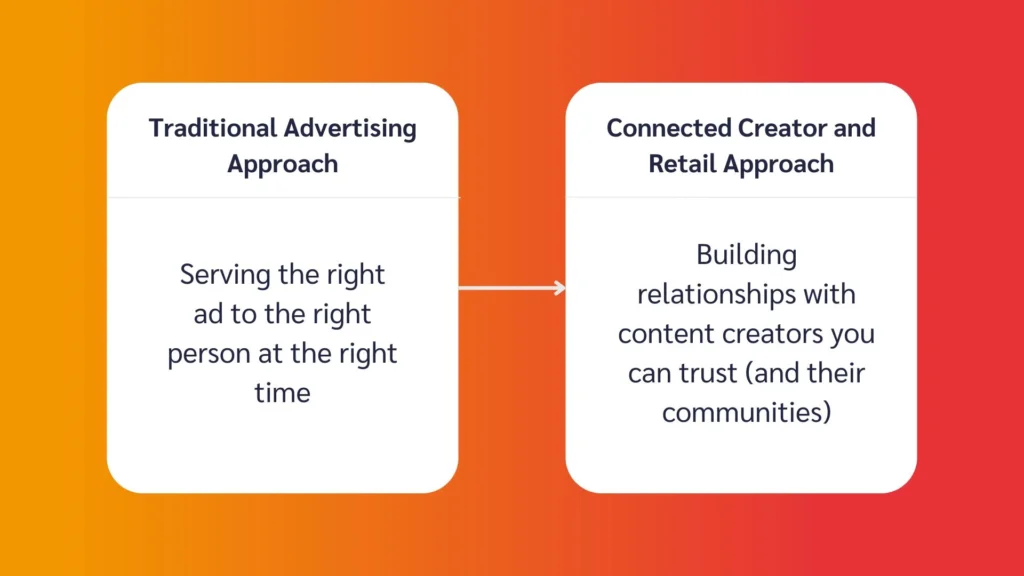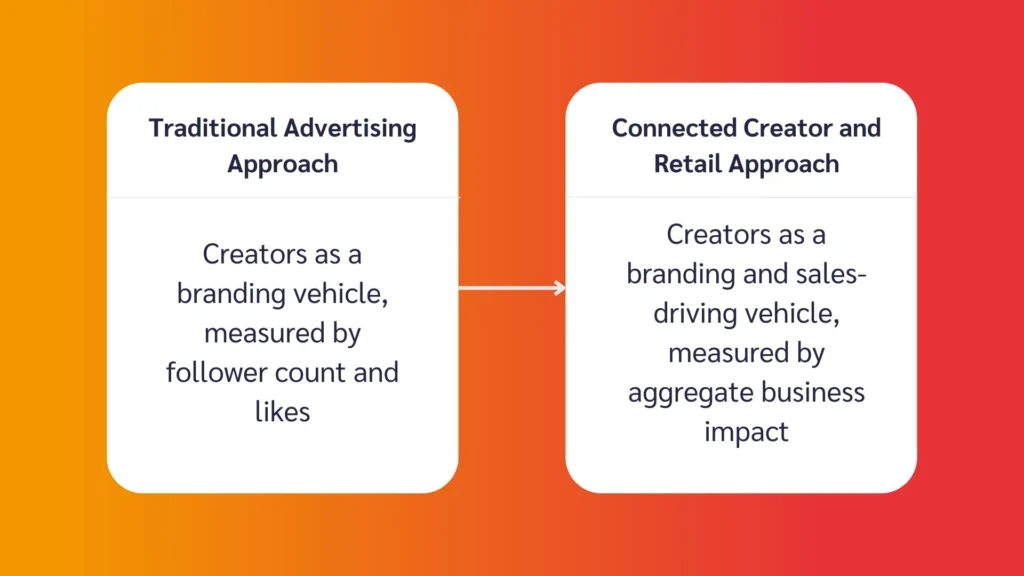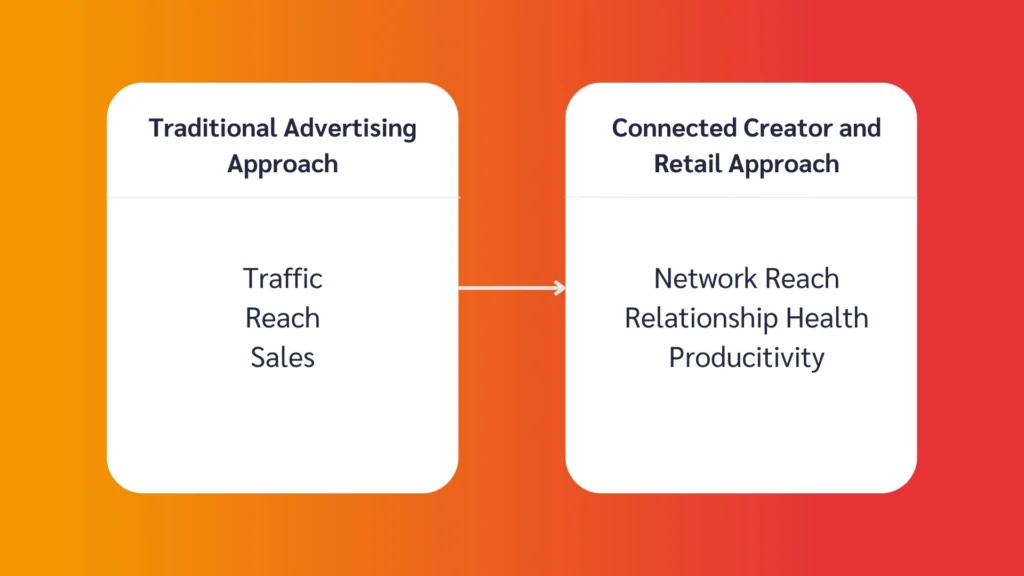While consumers intuitively weave between content and shopping experiences—such as using TikTok for discovery before purchasing on Amazon—most brands continue operating in disconnected silos, measuring creator partnerships with outdated metrics while keeping retail media in a separate performance bucket.
Let’s examine why authentic creator partnerships need to be a part of every brand’s marketing mix and how to implement actionable strategies for measuring impact across the entire customer journey, including at retail.
Whether you’re looking to improve ROI, build stronger customer relationships, or adapt to changing consumer behavior, these evidence-based approaches will help you develop an effective creator-retail media strategy.
Creators make content that consumers want
Creator-led platforms such as YouTube (used by 83 percent of U.S. adults), Instagram (47 percent), and TikTok (33 percent) demonstrate remarkable reach. Users engage deeply on these platforms each day—spending nearly an hour on Instagram and over ninety minutes on TikTok—making this level of activity noteworthy for advertisers.
Three factors are driving the enormous demand for creator-driven experiences:
1. Creator content is short, fast, and fresh
Creators generate content quickly, typically with a more raw and authentic finish compared to traditional advertising. This content remains highly current and relevant, creating a potent mix of speed and up-to-the-minute subject matter that draws consumer attention.
2. Creator content is trusted as authentic
Modern consumers are suspicious of brands and value social proof when it comes to influencing brand perception and sales. Trust and relatability are now table stakes, with 90 percent of consumers indicating that authenticity is important when deciding which brands they like and support.
3. Creator content is a valuable starting point for shoppers
Social and creator-driven channels are increasingly rivaling Google and Amazon as starting points for shopping searchers. Research shows that 42 percent of consumers start their product search on social and creator-led media channels.

Source: eMarketer
This shift in consumer behavior underscores a significant market evolution: Independent creators now shape much of the content modern consumers engage with.
Further, significant portions of the consumer’s shopping journey—from awareness through consideration—unfold on social media. While most purchases still occur on major retailer sites like Amazon, Walmart, and others, creator-driven platforms now play a powerful role in shaping buyer preferences.
But advertisers haven’t caught up
Chasing changes in consumer behavior is a perennial challenge for marketers, and it’s no different when it comes to the rise of the creator economy.
This issue becomes even clearer when observing how marketing budgets are allocated, especially in two key areas:
Media spending allocations haven’t moved with buyer behavior. Just as media spending was slow to follow the consumer shift to mobile, media dollars today are trailing behind on certain creator-led platforms—especially YouTube and TikTok.
| Platform | Share of total engagement | Share of total ad revenue | Over/underindex (share of revenue/engagement) |
| YouTube | 30% | 15% | 51% |
| 25% | 39% | 154% | |
| TikTok | 22% | 10% | 45% |
| 12% | 30% | 245% | |
| 4% | 0% | 5% | |
| Snapchat | 4% | 3% | 74% |
| X (Twitter) | 2% | 1% | 51% |
| 1% | 2% | 187% |
Sources used to calculate stats above: Datareportal, Soax, Statista, ExplodingTopics, Oberlo, Demandsage, Businessofapps, Reuters, Reddit Investors
Brands still invest more in professional creative development. Though the quality and value of professionally produced content still have a place, the imbalance in spending highlights deeper industry challenges in tapping into creator-produced content that drives authentic engagement on key social platforms.

Source for global ad revenue, creative services percentage, and creator earnings: Statista, First Liberty Building & Loan, eMarketer
Explaining the advertiser adoption gap
Marketers face a complex interplay of factors when trying to engage confidently, safely, and transparently on these platforms, such as:
- Lack of experience. Marketers are often less familiar with how to create meaningful content that genuinely resonates on emerging platforms like TikTok and in formats such as Reels. Media dollars tend to follow once the content is in place.
- Preference for traditional media. Established processes and key decision-makers, both within brands and their agencies, may have ingrained preferences for the traditional media formats they grew up producing. This comfort with established production models can slow the adoption of newer approaches.
- Lack of management tooling. There are too many creators to manage, and it’s difficult to measure their impact where it matters most—at retail. This leads to inefficiencies that make it nearly impossible to scale these programs effectively.
Bridging this gap calls for an evolution in how the industry approaches content, prioritizes media spending, and structures partnerships.
A new connected approach: The creator economy meets retail media
Today’s consumers are growing more skeptical of messages coming directly from companies, requiring businesses to develop new approaches to connect with their audience.
Fernando Fernandez, Global CEO of Unilever, captured this imperative in a fireside chat with Barclays, stating, “Messages from brands coming from corporations are suspicious messages. So, creating marketing activity systems in which others can speak for your brand at scale is very important.”
He points to the need for a new “machine of content creation,” operating at an unprecedented scale—envisioning influencer presence across thousands of localities and leveraging AI—so that “marketing activity systems of ‘others say’ at scale will be the fundamental principles of our marketing strategy.”
Crucially, Fernandez affirms that this commitment is driven by measurable success. He notes that Unilever has “the… methodology to measure the performance of our brands and their impact on brand equities,” and concerning these new approaches, he states unequivocally, “They are higher return” compared to any alternative allocation of funds.

Source: Barclays: Fireside Chat with Fernando Fernandez, CEO
Fernando’s vision of scalable, authentic advocacy describes the new paradigm that connects creator-led content and distribution with retail-enabled measurement.
The authenticity of and demand for creator content allow marketers to potentially engage consumers meaningfully at a large scale. By monitoring this content and measuring the performance at retail, marketers can protect their brands and invest in a way that drives returns. It also enables creators to appropriately benefit from new revenue streams.
There’s an enormous opportunity to connect creator content—authentic, quickly produced, high volume—and retail measurement.
At impact.com, we’re enabling this connection. Our platform is trusted by creators worldwide and serves as the partner performance management and measurement solution for 4,500 global brands, including 7 out 10 of North America’s leading online retailers.
Connecting creator engagement at scale with retail performance measurement is central to our retail media strategy. Our recent partnership with Best Buy highlights what’s possible.
As we assemble this new marketing activity system that combines creator engagement, content development and promotion, and performance measurement, we believe marketers should be guided by three principles.
Guiding principles for connecting creator marketing and retail media
1. Focus on partners, not just ads
The atomic unit of this paradigm is the creator. Marketers have sophisticated methods for planning, measuring, and optimizing media placements and ad creatives.
For example, performance marketers use multiple tools to discover and manage keywords and audience segments. They set bid rules to implement changes as ads are placed, A/B test creative for performance, and optimize in real time at the customer segment level.
The success of these techniques has driven performance, but it has also fueled consumers’ suspicions of brands and advertising. The performance tools of the last 30 years need to evolve to manage creators.
Finding success in this new environment isn’t about finding the best placement or bid strategy to see success. Instead, marketers must find and nurture mutually beneficial relationships with creators. It’s more like building a team than a media plan.
Brands that embrace creator-led marketing use these strategies to build effective partnerships:
- Performance-driven compensation. Brands shift from traditional flat fees to flexible, hybrid payment models that reward certain performance indicators and categorize creators by the success of their collaborations.
- Thoughtful creator recruitment. Brands work with creators based on a proven track record of alignment and genuine brand affinity, ensuring more authentic partnerships and stronger sales.
- Cultivating long-term relationships. Instead of focusing on one-off campaigns, brands invest in sustained partnerships that enhance trust and compound results over time.
Treating creators as valued team members, rather than just media channels, is essential to unlocking meaningful consumer engagement and sustained growth.

2. Measure at retail to enable holistic performance
Business impact should be measured and, over time, managed to drive positive results in creator collaborations. Creators are increasingly aware of their influence on business success. They want to share in the benefits and take responsibility for performance.
Fortunately, connecting retail media networks with creator content provides crucial infrastructure for such accountability, enabling comprehensive measurement of:
- Sales performance
- Media effectiveness
- Brand equity
However, as marketers demand new ways to understand creator program ROI, it’s clear that upper-funnel brand awareness metrics alone aren’t enough, and lower-funnel performance metrics only tell part of the story.
To address this, brands should connect retail measurement directly with creator activity, engagement, and compensation. This connection forms a core component of impact.com’s retail media value proposition.
Specifically, impact.com gives marketers full visibility into the entire customer journey. This allows marketers to see how different creators contribute at different stages—some driving top-of-funnel awareness, others influencing mid-funnel consideration, and others converting sales.
With this level of insight, brands can understand the true value of every creator, align compensation with their full contribution, and optimize and scale creator programs with greater precision and confidence.
Ultimately, this integrated approach to measurement empowers marketers to achieve a genuinely holistic understanding of their creator programs’ performance and overall business impact.

3. Monitor for compliance and brand safety
In the past, misaligned incentives sometimes led to inauthentic engagement or brand misalignment. When building creator relationships, brands must proactively manage the health and appropriateness of their creator partnerships alongside business impact.
The measurement of a brand-creator relationship needs to focus on:
- Alignment with brand principles
- Acceptable behavior within brand guidelines
- Generating consistent engagement
If a partner (or a brand) fails to meet mutually agreed-upon needs—such as clear communication, creative freedom within established guidelines, and mutual respect for brand values—then the relationship should be re-evaluated or potentially terminated.
However, relationships shouldn’t be terminated solely because specific sales targets weren’t met or brand affinity metrics didn’t immediately shift. Creators often contribute to other valuable goals that are part of a longer-term strategy, such as building brand awareness or consideration.
To maintain alignment and effectiveness, brands must:
- Proactively define the types of communities they wish to participate in
- Clarify their intended role in these spaces
- Establish clear objectives for their involvement
These foundational strategic decisions will then guide creator selection, partnership evaluation, and align all collaborations with overarching brand goals.

A strategic imperative: bridging the creator-retail gap
As consumers continue demanding more transparency from brands, the convergence of creator marketing and retail media represents a strategic imperative for brands seeking sustainable growth.
The brands that will thrive are those that recognize this essential shift and take decisive action, and will:
- Build authentic partnerships with creators based on shared values and measurable outcomes
- Implement comprehensive measurement systems that track the full customer journey
- Develop hybrid compensation models that align creator success with business results
- Create sustainable creator communities rather than relying on one-off campaigns
This new marketing paradigm requires technological infrastructure and strategic vision. At impact.com, we’re enabling this transition through our comprehensive platform that connects brands with creators, measures performance holistically, and scales relationships effectively across our network.
The question facing marketers isn’t whether to embrace this integrated approach, but how quickly they can adapt. As Fernando Fernandez of Unilever noted, the returns from these new systems significantly outperform traditional approaches. In a marketplace where consumer trust is the new currency, the competitive advantage belongs to those who act now.
Discover more about the future of marketing:
- From full funnel to full circle: 5 ways marketers can adapt to the new digital marketing funnel (blog)
- How AI, automation, and authenticity are changing influencer marketing with impact.com’s CMO, Cristy Garcia (blog)
- Drive full-funnel results by integrating your influencer and affiliate marketing programs (blog)




